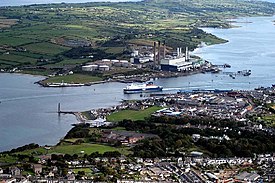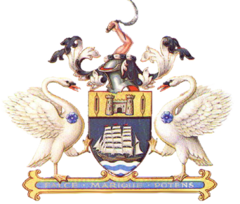Latharna
| Larne | |
|---|---|
 A birds-eye view looking south-east towards Larne Harbour, Islandmagee, and down the length of Larne Lough. Chaine Memorial Tower can be seen in the left of the picture, with Ballylumford power station behind the ferry. |
|
 Larne Coat of Arms |
|
| Larne shown within Northern Ireland | |
| Population | 32,180 (2011 Census) |
| Irish grid reference | D4102 |
| • Belfast | 30 km (19 mi) |
| District | |
| County | |
| Country | Northern Ireland |
| Sovereign state | United Kingdom |
| Post town | LARNE |
| Postcode district | BT40 |
| Dialling code | 028 |
| Police | Northern Ireland |
| Fire | Northern Ireland |
| Ambulance | Northern Ireland |
| EU Parliament | Northern Ireland |
| UK Parliament | |
| NI Assembly | |
Larne (from Irish: Latharna, the name of a Gaelic territory) is a seaport and industrial market town, as well as a civil parish, on the east coast of County Antrim, Northern Ireland with a population of 18,323 people in the 2008 Estimate. The Larne Local Government District had a population of 32,180 in 2011. It has been used as a seaport for over 1,000 years, and is today a major passenger and freight roll-on roll-off port. Larne is twinned with Clover, South Carolina which has named one of its schools, Larne Elementary School, after Larne. Larne is administered by Mid and East Antrim Borough Council. Together with the neighbouring district of Carrickfergus and part of Newtownabbey, it forms the East Antrim constituency for elections to the Westminster Parliament and Northern Ireland Assembly. The civil parish is situated in the historic barony of Glenarm Upper.
The coastal area around Larne has been inhabited for millennia, and is thought to have been one of the earliest inhabited areas of Ireland, with these early human populations believed to have arrived from Scotland via the North Channel. The early coastal dwellers are thought to have had a sophisticated culture which involved trading between the shores of the North Channel and between other settlements on the coasts of Scotland. The coast of Scotland is in fact clearly visible from here. Archaeological digs in the area have found flintwork and other artefacts which have been assigned dates from 6000 BC onwards. The term Larnian has even been coined by archaeologists to describe such flintworks and similar artefacts of the Mesolithic era (and one time to describe Mesolithic culture in Ireland as a whole). Larnian is also currently used to refer to people from Larne.
...
Wikipedia

